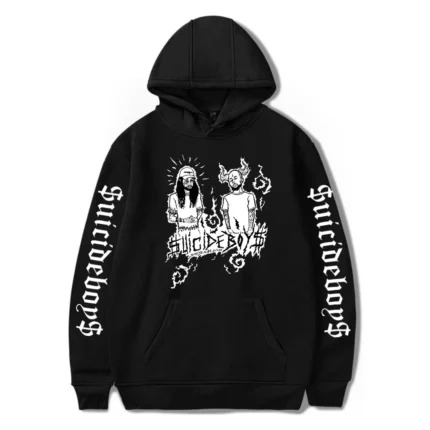The Evolution of $uicideboy$ Merch Over the Years
In the last decade, few underground music groups have left as strong a cultural imprint as $uicideboy$. Known for their raw lyricism, dark aesthetic, and unfiltered portrayal of mental health struggles, the New Orleans duo—comprising Ruby da Cherry and $lick $loth—has built a global cult following. Beyond their music, the $uicideboy$ brand has expanded into a fashion phenomenon, with their merchandise serving as both a visual extension of their sound and a symbol of belonging for fans.
Over the years, suicideboys merch has undergone a striking evolution, mirroring the duo’s own artistic growth while staying true to their underground roots. From gritty DIY designs to polished streetwear staples, the brand’s journey reflects the merging of music, art, and counterculture fashion.
Early Days: DIY Aesthetic and Underground Appeal
When $uicideboy$ first emerged in the mid-2010s, their merchandise was raw and unapologetic—much like their music. Early designs often featured:
- Lo-fi graphics inspired by punk and metal culture.
- Bold, unsettling imagery including skulls, grim reapers, and occult symbols.
- Hand-printed shirts and hoodies sold in limited quantities through small online shops.
These pieces were more than just clothing—they were artifacts of the group’s underground ethos. Fans wore them not to follow trends, but to declare allegiance to a movement that stood apart from mainstream hip-hop.
The limited availability of early $uicideboy$ merch contributed to its cult-like status. Owning a shirt or hoodie from these first drops felt like being part of a secret society—exclusive, rebellious, and fiercely loyal.
The Rise of a Cult Brand
As the duo’s popularity grew, so did their merch game. By 2016–2017, $uicideboy$ began releasing more professionally produced designs, but without losing the gritty aesthetic that defined their early years. This period saw:
- Higher-quality fabrics and more consistent printing methods.
- The introduction of caps, beanies, and long-sleeve shirts alongside hoodies and tees.
- Continued use of occult and horror imagery, but with sharper, more stylized art.
The shift reflected their growing fanbase, which now spanned continents. At concerts, entire crowds would be dressed in $uicideboy$ apparel, turning live shows into moving displays of their brand identity.
This was also the era when $uicideboy$ began embracing tour-exclusive merch drops, making each concert stop an opportunity for fans to grab rare pieces that wouldn’t be restocked online.
Collaborations and Expansion
By the late 2010s, $uicideboy$ merch had started blurring the line between band merchandise and full-fledged streetwear brand. Collaborations with underground artists, tattoo designers, and independent clothing labels elevated the quality and uniqueness of each release.
Some notable developments included:
- Limited-edition capsule collections with custom artwork.
- Experimentation with cut-and-sew pieces, such as distressed hoodies, acid-wash tees, and oversized silhouettes.
- Incorporating metal-inspired fonts and horrorcore visuals into streetwear-friendly designs.
This period cemented $uicideboy$ as more than just musicians—they had become cultural curators, fusing elements from punk, metal, and skate culture into a cohesive fashion identity.
The Pandemic Shift: Comfort Meets Identity
When the pandemic hit in 2020, loungewear and casual fashion took center stage. $uicideboy$ merch adapted naturally to this shift. Drops during this time leaned heavily into:
- Oversized hoodies with soft, heavyweight fabrics.
- Joggers and sweatpants featuring embroidered logos and side prints.
- Tie-dye and faded washes, tapping into the DIY aesthetic with a polished finish.
Fans, stuck at home, found these pieces perfect for daily wear, and the brand’s online sales surged. The designs retained the dark, gritty identity of $uicideboy$, but now catered to a lifestyle where comfort was as important as style.
Aesthetic Maturity: Cleaner, More Refined Designs
As $uicideboy$’s music evolved—moving from purely aggressive tracks to more varied, introspective projects—their merch also reflected a maturing aesthetic. While still embracing their horrorcore roots, recent collections have:
- Introduced simpler logo-based designs for a minimal, versatile look.
- Focused on premium materials that can compete with established streetwear labels.
- Offered monochrome color palettes alongside traditional dark, graphic-heavy styles.
This refinement didn’t alienate their core audience—it broadened it. Now, fans could wear $uicideboy$ merch in more settings without feeling out of place, allowing the brand to move closer to mainstream streetwear while staying authentic.
The Role of Social Media and Resale Culture
Social media has played a huge role in the evolution of $uicideboy$ merch. Instagram outfit posts, TikTok styling videos, and YouTube unboxings have amplified demand for certain pieces. Limited drops often sell out in minutes, and the resale market has turned some older items into collector’s pieces worth several times their original price.
This scarcity-driven hype aligns $uicideboy$ with brands like Supreme and Palace, where exclusivity fuels desirability. Owning rare $uicideboy$ merch is not just about fandom—it’s a fashion flex.
Cultural Impact: More Than Just Merchandise
Suicideboys Shirt is more than clothing—it’s a cultural statement. Wearing it is a nod to:
- The underground music scene and rejection of mainstream norms.
- Mental health awareness, as the duo’s music openly addresses depression, anxiety, and addiction.
- A sense of community, where fans instantly recognize each other through shared visual symbols.
For many, $uicideboy$ apparel is both armor and identity—a way to carry the band’s raw honesty into everyday life.
The Present and Future of $uicideboy$ Merch
Today, $uicideboy$ merch stands at a crossroads between underground authenticity and mainstream streetwear success. The brand has reached a point where:
- Quality rivals established streetwear labels like Fear of God Essentials and Anti Social Social Club.
- Designs balance nostalgia and modernity, keeping long-time fans engaged while attracting new ones.
- International shipping and pop-up shops make the merch accessible to a global audience.
Looking ahead, the potential is vast. We can expect:
- More artist collaborations blending music and visual art.
- Expansion into accessories like jewelry, skate decks, and bags.
- Possibly even sustainability-focused collections, as eco-conscious fashion continues to grow.
If history is any indicator, $uicideboy$ will continue evolving their merch to reflect both their artistic journey and the changing tides of fashion—always keeping one foot firmly planted in the underground scene that birthed them.
Conclusion: A Journey of Style and Substance
The evolution of $uicideboy$ merch is a story of transformation without compromise. From gritty DIY beginnings to globally recognized streetwear, their apparel has grown alongside their music, retaining the emotional depth and rebellious energy that made the duo iconic in the first place.
For fans, each piece is more than just a shirt or hoodie—it’s a wearable chapter of the $uicideboy$ legacy. As they continue to push boundaries in both sound and style, their merch will remain a powerful symbol of a movement that thrives in the shadows yet influences the world


